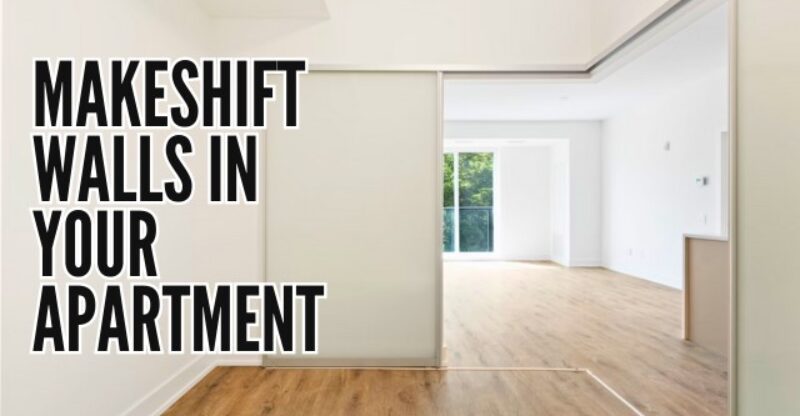Creating Makeshift Walls in Your Apartment: Maximizing Space
If you live in an apartments, you may have experienced the need for extra privacy or separate spaces. Whether you have a roommate or just want to create a designated workspace, makeshift walls in apartments can be a great solution.
These walls are temporary and can be easily removed without causing damage to the apartment. There are various types of makeshift walls that you can use in your apartments. One popular option is a bookcase wall, which involves using bookcases as a divider between spaces.
Another option is a tension rod wall, which uses tension rods and curtains to create a partition. Some people also use room dividers, such as screens or curtains, to create separate spaces in their apartments.
When creating a makeshift wall, it’s important to consider the safety and stability of the structure. Make sure the wall is sturdy and won’t topple over.
Also, be mindful of any building codes or regulations that may prohibit the use of makeshift walls in your apartments. With the right materials and proper installation, makeshift walls can be a great way to add privacy and create separate spaces in your apartment.
Makeshift Walls In Apartments and its Purpose
If you’re looking to divide a room or create an additional space in your apartment, a makeshift wall might be the solution for you. A makeshift wall is a temporary wall that can be easily installed and removed without making any permanent changes to your apartment.
These walls are perfect for creating a sense of privacy in shared living spaces, or for creating a home office or workout area.
The purpose of a makeshift wall is to create a barrier between different areas of your apartment. This can be useful if you want to create a separate sleeping area in a studio apartment, or if you want to create a home office in a shared living space.
A makeshift wall can also be used to hide unsightly areas of your apartment, such as exposed pipes or water heaters.
Materials Commonly Used
Several materials can be used to create a makeshift wall. The most common materials include:
- Bookshelves: Bookshelves are a popular choice for creating a makeshift wall. They can be easily moved and provide storage space for books and other items.
- Curtains: Curtains can be hung from the ceiling to create a temporary wall. They are easy to install and can be removed when not needed.
- Room dividers: Room dividers are designed specifically for creating temporary walls. They come in various styles and materials, including wood, metal, and fabric.
- Plywood: Plywood can be used to create a sturdy and durable makeshift wall. It can be painted or stained to match the decor of your apartment.
When choosing materials for your makeshift wall, it’s important to consider the weight and stability of the materials. You don’t want to use materials that are too heavy or unstable, as this could create a safety hazard.
Planning and Design
When it comes to creating makeshift walls in your apartments, proper planning and design are essential. This section will cover two key aspects of planning and design: assessing your space and needs, and design considerations.
Assessing Space and Needs
Before you start building a makeshift wall, it’s important to assess your space and needs. This will help you determine the size, location, and type of wall that will work best for your situation. Consider the following questions:
- How much space do you have? Measure the area where you plan to install the wall to ensure that it will fit properly.
- What is your budget? Determine how much you can afford to spend on materials and labor.
- What is the purpose of the wall? Are you creating a new room, dividing an existing one, or simply adding privacy?
- What type of wall do you need? Do you want a permanent or temporary wall? Will it be load-bearing or non-load-bearing?
By answering these questions, you can determine the best course of action for your makeshift wall project.
Design Considerations
Once you’ve assessed your space and needs, it’s time to consider the design of your makeshift wall. Here are some design considerations to keep in mind:
- Materials: What materials will you use for your wall? Some popular options include drywall, plywood, MDF, and fabric.
- Aesthetics: How will your wall look? Will it match the existing decor of your apartment? Consider using paint, wallpaper, or other decorative elements to make your wall look more appealing.
- Soundproofing: If you’re creating a new room or dividing an existing one, you may want to consider soundproofing your wall to reduce noise transmission.
- Lighting: Will your wall block natural light? Consider installing a window or using artificial lighting to ensure that your space remains bright and welcoming.
By taking these design considerations into account, you can create a makeshift wall that is both functional and visually appealing.
Construction Techniques
When building a makeshift wall in your apartment, there are two main construction techniques to keep in mind: building a temporary wall frame and attaching panels and finishes.
Building a Temporary Wall Frame
The first step in building a temporary wall is to construct a frame. You can use 2×4 or 2×3 lumber to create a sturdy frame that is strong enough to support the weight of the wall.
You should measure the area where you want to place the wall and cut the lumber to the appropriate length. Then, assemble the frame by attaching the pieces of lumber with screws or nails.
To ensure that the frame is level, use a level tool to check that the top and bottom plates are straight. You can also use shims to adjust the frame if it is not level.
Once the frame is assembled, stand it up in the desired location and secure it to the floor and ceiling with screws or nails.
Attaching Panels and Finishes
Once the frame is in place, you can attach panels and finishes to complete the wall. You can use drywall, plywood, or even fabric to cover the frame and create a finished look.
If you choose to use drywall, you will need to cut it to size and attach it to the frame with drywall screws. Then, you can apply joint compounds to the seams and sand them down to create a smooth surface.
If you prefer a more decorative finish, you can use fabric or wallpaper to cover the wall. Simply cut the fabric or wallpaper to size and attach it to the frame with staples or adhesive.
Remember to always follow safety guidelines when constructing a temporary wall. Use appropriate safety gear such as gloves and goggles, and make sure to secure the wall properly to prevent it from falling or collapsing.
Safety and Stability
When building a makeshift wall in your apartment, safety and stability are of utmost importance. You don’t want the wall to collapse or cause any damage to your apartment. Here are some tips to ensure your wall is secure and safe.
Support and Balance
To ensure your wall is stable, you need to have proper support and balance. The wall should be supported by the floor, ceiling, and walls.
You can use a stud finder to locate the studs in your wall and then attach the temporary wall to them using screws or nails. Make sure the screws or nails are long enough to penetrate the studs and secure the wall firmly.
You should also ensure that the wall is balanced. If the wall is not balanced, it can easily tip over and cause damage or injury. You can use a level to check if the wall is balanced. If the wall is not level, you can use shims to level it out.
Risk Mitigation
There are several risks associated with building a makeshift wall in your apartment. These risks include fire hazards, electrical hazards, and structural hazards. To mitigate these risks, you should take the following precautions:
- Avoid building the wall near electrical outlets or wiring.
- Do not obstruct any heating or cooling vents.
- Use fire-resistant materials for the wall.
- Do not exceed the weight limit of the wall.
- Do not attach anything heavy to the wall.
By taking these precautions, you can ensure that your makeshift wall is safe and secure. Remember to always prioritize safety when building any structure in your apartment.
Legal and Ethical Considerations
When building a makeshift wall in your apartment, there are several legal and ethical considerations to keep in mind. This section will cover the basic regulations and privacy concerns you should know.
Tenant and Landlord Regulations
Before building a makeshift wall, it is important to check with your landlord or property management company to ensure that it is allowed.
Some leases prohibit tenants from making structural changes to the apartment, including building walls. Violating these rules can result in fines or even eviction.
If your landlord does allow temporary walls, there may be specific regulations that you need to follow. For example, some landlords require that the wall be freestanding and not attached to the ceiling or floor. Others may require that the wall be constructed with fire-resistant materials.
It is important to follow these regulations to ensure that you are not breaking any rules or putting yourself and others in danger.
Privacy Concerns
When building a makeshift wall, you should also consider the privacy of your neighbors. If the wall is not soundproof, it may allow noise to travel between apartments. This can be especially problematic if you have loud roommates or neighbors.
To minimize noise, you can use soundproofing materials such as acoustic foam or mass-loaded vinyl. These materials can help absorb sound and prevent it from traveling through the wall.
It is also important to consider the privacy of your apartment. If you are building a wall to create a separate bedroom or office, make sure that it is not visible from outside your apartment. This can be a violation of privacy and may make your apartment less secure.
By following these legal and ethical considerations, you can ensure that your makeshift wall is safe and respectful to both you and your neighbors.
Conclusion
Creating makeshift walls in your apartments can be a great way to maximize space and create privacy. With careful planning, the right materials, and adherence to safety and legal considerations, you can build a wall that suits your needs and enhances your living space.
FAQs
Makeshift walls are often designed with renters in mind, offering flexibility and easy installation without causing permanent damage to the property.
You can use soundproofing materials like acoustic foam or mass-loaded vinyl to minimize noise transmission through your makeshift wall.
The cost of installing a makeshift wall can indeed vary greatly depending on the materials used and the complexity of the project. For a more professional setup using pressurized walls, it could range from $700 to $2000. Always consult with a professional for an accurate estimate.
You can decorate your makeshift wall to match the decor of your apartment. You can use paint, wallpaper, or other decorative elements to enhance the look of your wall.



